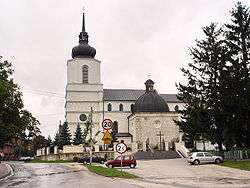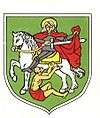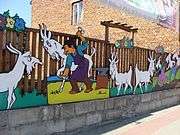Pacanów
| Pacanów | ||
|---|---|---|
 | ||
| ||
 Pacanów | ||
| Coordinates: 50°24′N 21°3′E / 50.400°N 21.050°E | ||
| Country |
| |
| Voivodeship | Świętokrzyskie | |
| County | Busko-Zdrój County | |
| Gmina | Gmina Pacanów | |
| Area | ||
| • Total | 7.13 km2 (2.75 sq mi) | |
| Population (2003) | ||
| • Total | 1,137 | |
| • Density | 160/km2 (410/sq mi) | |
| Time zone | CET (UTC+1) | |
| • Summer (DST) | CEST (UTC+2) | |
| Postal code | 28-133 | |
| Area code(s) | +48 41 | |
| Car plates | TBU | |
| Website | http://pacanow.pl | |
Pacanów [paˈt͡sanuf], sometimes referred to as the European Capital of Fable, is a village in Busko County, Świętokrzyskie Voivodeship in south-central Poland. It is the seat of Gmina Pacanów. It had a population of 1137 in 2003. The village's sołtys is Jan Łuszcz and the wójt is Wiesław Skop. In modern times the village is partly noted for its connection to the fictional character Koziołek Matołek. It lies in historic Lesser Poland, approximately 25 kilometres (16 mi) east of Busko-Zdrój and 62 km (39 mi) south-east of the regional capital Kielce.
History
Pacanów was first mentioned in a document from 1110 - 1117, issued by Bishop of Kraków Maur, in which construction of St. Martin church was confirmed. At that time, the village probably belonged to a man named Siemian, who is mentioned in the document. The existence of the parish church was confirmed on August 1219 by Bishop of Kraków Iwo Odrowąż, and in 1265, the village was granted Magdeburg rights by Prince Bolesław V the Chaste. In the same period, a number of local villages were also granted town charters (Połaniec, Nowy Korczyn, Koprzywnica and Opatowiec). Original charter of Pacanów has not been preserved, but in a document issued on February 26, 1603, King Zygmunt III Waza stated that Pacanow had been incorporated as a town in 1265.
Pacanów remained a private town, belonging, among others, to a man named Piotr of Mokrsko and Pacanów, Castellan of Małogoszcz, (1306-1310), Wiślica (1315), and Sandomierz (1317-1328). By 1417, the town already had a parish school, and in 1433 in Nowy Korczyn, King Władysław Jagiełło confirmed its Magdeburg rights, allowing a number of fairs to be organized here. In 1502, during a Tatar raid, in which the invaders crossed the Vistula, Pacanów was successfully defended. The significance of the town was confirmed when Pacanów was placed on the map of Eastern Europe by Nicholas of Cusa. In 1583 and 1585 King Stefan Batory stayed here briefly. Good times came to end during the Swedish invasion of Poland. On April 9, 1657, the town was captured by Transilvanian army of George II Rakoczi. The invaders burned Pacanów to the ground, and this event marked the decline of the town, which never recovered from the losses. After Partitions of Poland, Pacanów, which for centuries belonged to Sandomierz Voivodeship, became part of the Habsburg Empire, and in 1815 - 1915, it belonged to Russian-controlled Congress Poland. On August 24, 1813, the town was completely flooded by the Vistula, and in 1820, Pacanów had app. 1,000 residents, half of whom were Jewish. In 1869, Russian government reduced Pacanów to the status of a village.
By 1928, already in Kielce Voivodeship of the Second Polish Republic, the population was 2500, with majority of Jews, who controlled most local businesses and stores. Pacanów's Jews perished in the Holocaust, when in November 1942, they were transported by Germans to Treblinka death camp.[1]
Notable people
- Feliks Paweł Jarocki
- Zelig Mansdorf - Served as President of the Pachanower Young Men's Benevolent Association, a society founded in America by the Jews who immigrated prior to the Nazi extermination of the Jews of Pacanow in 1942. A burial site is maintained in Beth David Cemetery in Elmont, NY.
Koziołek Matołek
The fictional character Koziołek Matołek, or Matołek the Billy-Goat in English, was from Pacanów and it was where his adventures were set. He was created by Kornel Makuszyński (story) and Marian Walentynowicz (art) in one of the first and most famous Polish comics back in 1933.
Once when Makuszyński and Walentynowicz were sitting in a coffee house in Kraków, they spotted a sad looking man sipping a drink at a nearby table. They asked him why he looked so gloomy, and he told them that he came from the small town of Pacanów and was wondering how to help the town prosper. Makuszyński and Walentynowicz decided then to help him by popularizing the small town in their books.
It became a cult classic, popular since its creation till today, and becoming an important part of canon of Polish children's literature. The comic has influenced many generations of Poles, and some of its phrases have penetrated into the Polish language itself, with expressions like 'w Pacanowie kozy kują' (In Pacanów, they shoe goats), 'pacan' and 'matoł' (slowpoke, dummy). Later it was made into a children's cartoon.
To this day Koziołek Matołek remains Pacanów's claim to fame, and images of him can been seen all around the village.
|
References
External links
- Pacanów official site
- Pachanower Young Men's Benevolent Association]
Coordinates: 50°24′N 21°03′E / 50.400°N 21.050°E






